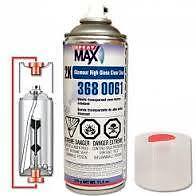-40%
Microflex SG-375 SafeGrip Medium Disposable Latex Blue Exam Gloves - 500pk
$ 86.05
- Description
- Size Guide
Description
Features and Benefits3 TIMES THICKER THAN STANDARD LATEX GLOVES - Ansell Microflex SG-375 is the thickest latex gloves offered by Ansell. It will prevent rips and tears making this glove ideal for heavy duty applications in industrial, mechanical, or medical environments
TEXTURED FINGERS FOR SECURED GRIP - Featuring Microflex Safe grip technology, this examination glove will provide workers a reliable grip in their handling of tools or equipment's: A perfect adding value for jobs in labs, Clinique's or in the industry
EXTENDED CUFF FOR EXPANDED PROTECTION - This powder free natural rubber glove with long cuff protects wrist and forearm for extra safety in handling hazardous chemicals or other liquids. An enhanced safety in every type of environment
AVAILABLE IN MANY SIZES FOR AN OPTIMAL WEAR - Ansell Microflex gloves are available in Small, Medium, Large and Extra-large for convenience to every type of hand. Gloves come in dispensers of 50 units
ADVANCED DISPOSABLE HAND PROTECTION - Whatever the task, and whatever the environment, customers around the world can rely on MICROFLEX’s advanced hand protection solutions to go beyond protection to improve worker comfort and productivity
The Microflex SafeGrip disposable, chlorinated, powder-free, extended length latex glove has textured fingertips. It has a palm thickness of 11.0 mils and a finger thickness of 14.2 mils and is 11.6" long from the tip of the middle finger to the edge of the beaded wrist cuff, which is 7.9 mils thick. The extended length cuff helps protect the hand, wrist, and forearm. The glove is suitable for automotive, emergency medical services, healthcare, industrial safety, laboratory, and mortuary applications. Latex provides better elasticity than nitrile, chloroprene, or vinyl, and better puncture resistance than vinyl. The glove is textured on the ends of the fingers for improved grip compared to a glove with a smooth texture. It has been washed in a diluted chlorine-based solution to help reduce tackiness, providing lower surface friction than a non-chlorinated glove and allowing quick donning in wet environments. This powder-free glove leaves no residue, helping to reduce the likelihood of spreading latex allergens and bacteria compared to a powdered glove. The glove meets the emergency medical glove requirements of the National Fire Protection Association (NFPA) code 1999 (2008 edition). The color of this ambidextrous glove is blue.
Tensile strength, measured in megapascals (MPa), is the amount of force required to rip a glove; the higher the number, the stronger the glove material. This glove has a tensile strength of 34 MPa before aging and 28 MPa after aging. Elongation measures how much a glove can be stretched before it breaks. It is expressed as a percent of the original length of the glove at the moment of breakage, and the higher the percent, the more the glove can stretch. This glove has an elongation of 750% before aging and 600% after aging. Acceptable Quality Level (AQL) is a Food and Drug Administration (FDA) quality specification for the defect rate in surgical and exam gloves. The FDA requires an AQL of 1.5 for surgical gloves and 2.5 for exam gloves. This glove has an AQL of 1.5, which means the defect level from a large sample of the gloves will not exceed 1.5%. Microflex examination gloves meet or exceed applicable standards imposed by ASTM International, formerly known as the American Society for Testing and Materials (ASTM), and the FDA.
Disposable and limited-use gloves are used in medical, forensic, scientific, art, and industrial applications. Gloves are commonly made from flexible materials such as latex, nitrile, chloroprene, and vinyl. While most disposable gloves are designed for either hand, some can be purchased in hand-specific models. They are offered powdered or powder-free; silicone or silicone-free; chlorinated or non-chlorinated; coated or uncoated; with a standard- or extended-length cuff; sterile or non-sterile; and with textured or smooth fingers, fingertips, and palms. A glove's abrasion, cut, and puncture resistance is defined by glove material and thickness, and may be improved with the use of certain exterior coatings. Abrasion resistance means the glove helps protect the hand from contact with rough objects. Cut resistance means the glove helps protect the hand from blades and sharp instruments. Puncture resistance means the glove helps protect the hand from pointed objects such as pins and needles. Chemical resistance means the glove helps protect the hand from certain chemicals. Chemical resistance is defined by glove material, thickness, and length, as well as the work environment and chemicals likely to be encountered. For information on the chemical resistance of this glove, consult the manufacturer's chemical resistance guide.
Microflex Corporation manufactures disposable gloves. The company, founded in 1988 and headquartered in Reno, NV, meets International Organization for Standardization (ISO) 13485:2003.














